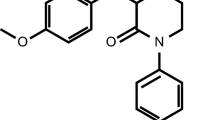Abstract
The purpose was to assess the effect of different doses and different routes of acetylsalicylic acid (ASA) administration on platelet aggregation and the comparison between platelet aggregation after the single and the repetitive administration of ASA in healthy individuals and in patients after ischemic stroke. The study group consists of 22 healthy individuals and 30 patients with documented ischemic stroke. Platelet aggregation was measured in healthy individuals: (a) twice before ASA and (b) 2 h after different single doses and different routes of ASA administration—(b1) 500 mg orally, (b2) 500 mg intravenously, and (b3) 100 mg orally. We measured aggregability in healthy individuals after five consecutive days of 100 mg of ASA q.d. and in patients on chronic ASA 100 mg q.d. The VerifyNow was used with results expressed in aspirin reaction units (ARU). In healthy individuals, the dose—(b1) 500 mg orally—reduced the aggregability to mean (SD) 392 (36) ARU (p < 0.001), (b2) 500 mg intravenously to 428 (46) (p < 0.001) and (b3) 100 mg orally to 460 (76) (p < 0.001). The suppression of aggregation after 500 mg was (p = 0.029) higher after the oral compared to intravenous administration, and the same is true for the suppression after single dose of 500 mg orally and 100 mg orally (p = 0.011). Oral dose 100 mg for 5 days in healthy individuals reduced aggregation to 405 (37) and in post-stroke patients to 433 (54). All doses of ASA, both orally and intravenously, have produced a significant reduction of platelet aggregation. Preference of the parenteral to oral application has not been established.



Similar content being viewed by others
References
Antiplatelet trialists collaboration. Collaborative overview of randomized trials of antiplatelet therapy. Prevention of death, myocardial infarction and stroke by prolonged antiplatelet therapy in various categories of patients. Br Med J. 1994;308:81–106.
Antithrombotic trialists’ collaboration. Collaborative meta-analysis of randomised trials of antiplatelet therapy for prevention of death, myocardial infarction and stroke in high risk patients. Br Med J. 2002;324:71–86.
Bauer J. Antikoagulační terapie v prevenci a léčbě ischemických iktů. Cesk Slov Neurol N. 2010;73:480–91.
User Manual, Accumetrics Inc., USA. VerifyNow System 2006; 1–122.
Alušík Š, Jedličková V, Paluch Z, Lejsková M. Determination of plasma salicylic acid levels to assess compliance to acetylsalicylic acid therapy. Chem Listy. 2010;104:803–6.
Harrison P, Frelinger 3rd AL, Furman MI, Michelson AD. Measuring antiplatelet drug effects in the laboratory. Thromb Res. 2007;120:323–36.
Grove EL. Antiplatelet effect of aspirin in patients with coronary artery disease. Dan Med J. 2012;59:B4506.
Hohlfeld T, Weber AA, Junghans U, Schumacher M, Boucher M, Schrör K, et al. Variable platelet response to aspirin in patients with ischemic stroke. Cerebrovasc Dis. 2007;24(1):43–50.
Gurbel PA, Bliden KP, DiChiara J, Newcomer J, Weng W, Neerchal NK, et al. Evaluation of dose-related effects of aspirin on platelet function: results from Aspirin-Induced Platelet Effect (ASPECT) study. Circulation. 2007;115:3156–64.
Patrono C, Bachmann F, Baigent C, Bode C, De Caterina R, Charbonnier B, et al. Expert consensus document on the use of antiplatelet agents. The task force on the use of antiplatelet agents in patients with atherosclerotic cardiovascular disease of the European Society of Cardiology. Eur Heart J. 2004;25:166–81.
Hamm CW, Bassand JP, Agewall S, Bax J, Boersma E, Bueno H, et al. ESC guidelines for the management of acute coronary syndromes in patients presenting without persistent ST-segment elevation: the task force for the management of acute coronary syndromes (ACS) in patients presenting without persistent ST-segment elevation of the European Society of Cardiology (ESC). Eur Heart J. 2011;32:2999–3054.
Nielsen HL, Kristensen SD, Thygesen SS, Mortensen J, Pedersen SB, Grove EL, et al. Aspirin response evaluated by the VerifyNow aspirin system and light transmission aggregometry. Thromb Res. 2008;123:267–73.
Fontana P, Nolli S, Reber G, de Moerloose P. Biological effect of aspirin and clopidogrel in a randomized cross-over study in 96 healthy volunteers. J Thromb Haemost. 2006;4:813–9.
Snoep JD, Hovens MM, Eikenboom JC, van der Bom JG, Huisman MV. Association of laboratory-defined aspirin resistance with a higher risk of recurrent cardiovascular events: a systematic review and meta-analysis. Arch Intern Med. 2007;167:1593–9.
Krasopoulos G, Brister SJ, Beattie WS, Buchanan MR. Aspirin “resistance” and risk of cardiovascular morbidity: systematic review and meta-analysis. Br Med J. 2008;336:195–8.
Sztriha LK, Sas K, Seres E, Boda K, Lenti L, Csifcsak G, et al. Optical platelet aggregometry does not appear useful as a means of assessing the risk of recurrent vascular events in aspirin-treated patients. Acta Neurol Scand. 2008;117:250–4.
Acknowledgments
This study was supported by a research project at Charles University PRVOUK P34, PRVOUK 35, 260045/SVV/2014 and by project 266705/SVV/2013.
We gratefully acknowledge the laboratory assistance of Robert Petr, MD, Miss Veronika Klimešová, and Mrs. Hana Směšná.
Conflict of Interest
Author Miroslava Chýlová, Author Zuzana Moťovská, Author Pavel Osmančík, Author Bohumir Procházka, and Author Pavel Kalvach declare that they have no conflict of interest. None of the authors has any affiliation with pharmaceutical and industrial manufacturers of the discussed drugs or instruments.
Author information
Authors and Affiliations
Corresponding author
Electronic Supplementary Material
Below is the link to the electronic supplementary material.
ESM 1
(DOC 65 kb)
Rights and permissions
About this article
Cite this article
Chýlová, M., Moťovská, Z., Osmančík, P. et al. The Effect of Different Doses and Different Routes of Acetylsalicylic Acid Administration on Platelet Aggregation in Healthy Volunteers and Ischemic Stroke Patients. Transl. Stroke Res. 6, 160–165 (2015). https://doi.org/10.1007/s12975-014-0382-6
Received:
Revised:
Accepted:
Published:
Issue Date:
DOI: https://doi.org/10.1007/s12975-014-0382-6




